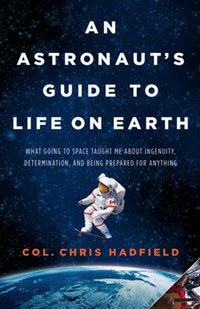Review: An Astronaut's Guide to Life on Earthby Jeff Foust
|
| However, while the concept of writing a book may be rather old-school, An Astronaut’s Guide to Life on Earth is not the typical astronaut memoir. |
Instead, Hadfield harnessed the growing power of social media to reach out directly to the public. He posted images of the Earth he took while on the station to his Twitter account and videos of life on the station to YouTube, among other activities; simple things, but ones that resonated with the public. Today, Hadfield has almost one million followers on Twitter; Canadian Prime Minister Stephen Harper, by comparison, has fewer than 400,000 followers. His most famous YouTube video, a performance of David Bowie’s “Space Oddity” while still on the station, has racked up more than 19 millions views. Not exactly “Gangnam Style” territory, but extraordinarily successful as far as space-related videos go.
It’s a bit ironic, then, that upon his return to Earth Hadfield has gone in the direction of conventional media, with the book An Astronaut’s Guide to Life on Earth. Hadfield is also doing the classic approach to book publicity, currently crisscrossing the continent on a book tour, and doing the traditional media interviews along the way, from an interview on NPR’s “Fresh Air” program to an appearance on Conan O’Brien’s late-night television show. (Perhaps this focus on bigger, and more traditional, media is why the publisher declined to provide a review copy of the book to this publication, a courtesy most other publishers have generally offered.)
However, while the concept of writing a book may be rather old-school, An Astronaut’s Guide to Life on Earth is not the typical astronaut memoir. Hadfield does tell a lot about his life, including his path to becoming an astronaut and his three space flights, in the book, but the book is not structured as a basic, chronological biography. Instead, as the title suggests, Hadfield offers advice in the form of the lessons he learned on his path to becoming an astronaut that he argues apply to those who have no desire to be astronauts. “See, a funny thing happened on the way to space: I learned how to live better and more happily here on Earth,” he writes.
Hadfield offers that advice in the book in the form of vignettes from his own life and career. If there’s a core piece of advice in the book, it’s to be competent: “the most important quality to have if you’re an astronaut—or, frankly, anyone, anywhere, who is striving to succeed at anything at all.” That includes attention to detail (“sweating the small stuff,” as he puts it), anticipating problems, and not seeking to stand out (“aim to be a zero.”) Those qualities are essential to be a successful astronaut, or a success almost anywhere else, he argues.
There are, to be sure, plenty of biographical details Hadfield includes in the book that are not strictly associated with his titular guide to living. He goes into detail about a medical issue, not publicly known at the time, that threatened his mission to the ISS. He had surgery in 1990 to remove scar tissue in his abdomen left over from a childhood appendectomy that was constricting his intestines. That surgery hadn’t prevented him from becoming an astronaut, but the intestinal blockage reoccurred in late 2011, as he was training for his mission. A similar surgery would have taken him off of the mission and, likely, ended his astronaut career. He instead had a much less invasive laparoscopic procedure, but it took months to convince NASA flight surgeons that he was fit to fly, a debate that even he was largely excluded from. “The secrecy and paternalism really bothered me,” he writes. “They trusted me at the helm of the world’s spaceship, but had been making decisions about my body as though I was a lab rat who didn’t merit consultation.”
| “See, a funny thing happened on the way to space: I learned how to live better and more happily here on Earth,” he writes. |
He also discusses his new media outreach while on the ISS that catapulted him to at least the lower orbits of celebrity. The public, he writes, cares “about the big picture, yes, but they’re enthralled by the human aspects of space exploration, the minutiae of daily life on board the ISS.” He also credits the work of his son, Evan, who helped coordinate Hadfield’s social media activities while in space. “To him,” he writes, “it had become a challenge: How many more people could he get hooked on space?”
The answer to that appears to be in the many thousands or millions, based on the swelling number of Twitter followers Hadfield has; he had fewer than 100,000 at the beginning of the year. An Astronaut’s Guide to Life on Earth may win over a few more, too: he manages to tell the story of his life in a way that provides lessons for others to follow, even if they have no desire themselves to fly in space. Hadfield’s celebrity made fade over time, depending on what he decides to do in his post-astronaut career (something he doesn’t touch upon in the book), but this book offers not only a glimpse at his achievements, but also advice to help readers achieve their own goals.
